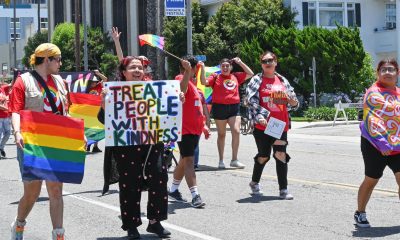Southern California
Flash flood warning LA County; Snow & heavy rain impact travel
The California Highway Patrol is cautioning that dangerous mountain driving conditions are currently affecting travel
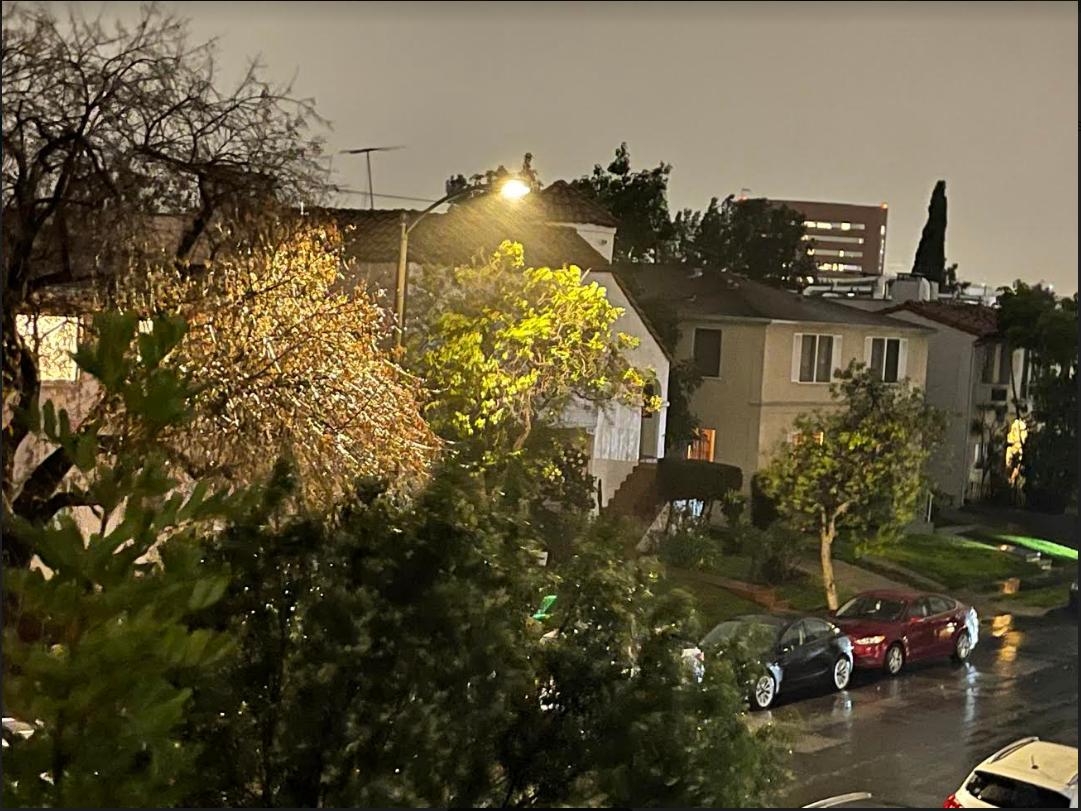
OXNARD – The National Weather Service has issued a flash flood watch for parts of LA County. The Flash Flood Warning has been expanded to include nearly 6 million people in metro Los Angeles. It remains in effect until 10 p.m.
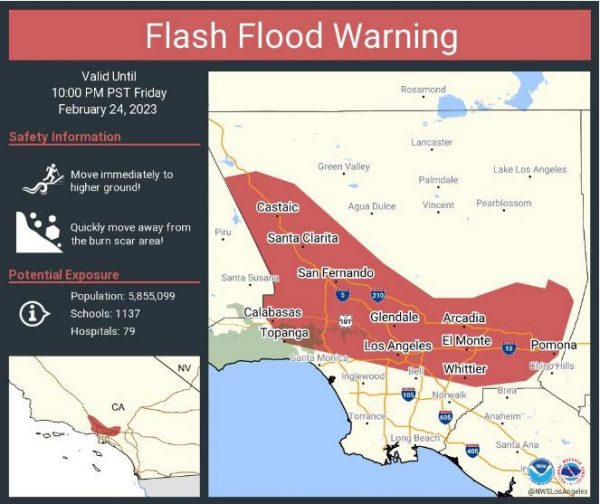
The California Highway Patrol is cautioning that dangerous mountain driving conditions are currently affecting travel. Drivers are urged to avoid traveling on mountain roads through Saturday.
Currently CHP units are conducting escorts through the Grapevine on the 5 Freeway: “Units from the Fort Tejon and Newhall areas are conducting escorts through the Grapevine. Road conditions are still very wet. Do not attempt to pass the CHP officers conducting the escorts. The weather conditions are expected to last through the night so please travel safe.”
Heavy band of rain moving into Ventura County, dangerous mountain driving conditions persist
A band of heavier rain is expected to move into Ventura County between 7 p.m. and 11 p.m. Friday night, “capable of producing rainfall rates locally to 1 inch per hour,” said NWS.
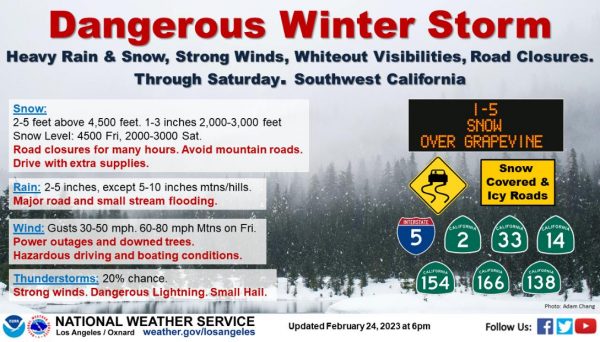
Updated Cold Weather Alert, Cold Temperatures Expected in Parts of Los Angeles County
The Los Angeles County Health Officer is issuing a Cold Weather Alert due to the National Weather Service’s forecast for low temperatures. Wind chill temperatures are expected to be below 32 degrees Fahrenheit. Affected areas include:
- Santa Clarita Valley – Friday, February 24, 2023 to Sunday, February 26, 2023 (continued)
- Lancaster (Antelope Valley) – Friday, February 24, 2023 to Tuesday, February 28, 2023 (continued)
- Mount Wilson (LA County Mountains) – Friday, February 24, 2023 to Tuesday, February 28, 2023 (continued)
- Woodland Hills (West San Fernando Valley) – Sunday, February 26, 2023
- Burbank (East San Fernando Valley) – Sunday, February 26, 2023
- San Gabriel (West San Gabriel Valley) – Sunday, February 26, 2023
- Pomona (East San Gabriel Valley) – Sunday, February 26, 2023
“Taking extra precautions amid cold weather events is especially important for children, the elderly, those with disabilities, and those with special medical needs,” said Muntu Davis, MD, MPH, Los Angeles County Health Officer. “Shelters and other public facilities are open for those who have no access to a warm space. It’s also important for everyone to make sure they are staying warm safely—never heat a home with a stove, oven, or barbeque as this could lead to carbon monoxide poisoning.”
During these cold weather conditions, you can do several things to help yourself and others stay safe:
- Avoid carbon monoxide poisoning. Never use a generator inside a home, shed or garage even if doors and windows are open. Keep generators outside and far away from windows, doors and vents.
- Never use charcoal grills or camp stoves indoors. Deaths have occurred after people burned charcoal or used camp stoves in enclosed spaces, which produced lethal levels of carbon monoxide.
- Never heat your home with a gas stovetop or oven.
- Do not touch or approach a downed power line; call 9-1-1 if you see a downed or damaged electrical line.
- Avoid using candles. If possible, use flashlights instead. If you must use candles, do not burn them on or near anything that can catch fire. Never leave burning candles unattended or near children or bedding. Extinguish candles when you leave the room.
- Have a plan for back-up power if you or someone in your family is dependent on electricity for medical devices.
- Wear layers and have blankets available to add additional warmth. Layers will keep you warmer than a bulky sweater. Stay dry to avoid hypothermia.
- If it is safe, check on neighbors who may need assistance — older adults, people with disabilities and young children are more at risk in extreme cold.
Health Risks
Hypothermia: People exposed to cold weather for prolonged periods can lose body heat and develop hypothermia. Symptoms vary depending on how long you are exposed to cold temperatures. Early symptoms of hypothermia include shivering, fatigue, loss of coordination, and confusion and disorientation. Late symptoms of hypothermia include no shivering, blue skin, dilated pupils, slowed pulse and breathing, and loss of consciousness.
Frostbite: People exposed to extremely cold weather conditions with snow and freezing temperatures may be at risk of frostbite. Frostbite is a bodily injury caused by freezing that results in loss of feeling and color in affected areas. The most common affected areas are the nose, ears, cheeks, chin, fingers, or toes. Gently warm the person and seek immediate medical care if you believe someone is showing signs of hypothermia or frostbite.
Carbon monoxide poisoning: Carbon monoxide (CO) is an odorless, colorless gas that can kill you. It is found in fumes produced any time you burn fuel in cars or trucks, small engines, stoves, lanterns, grills, fireplaces, gas ranges, or furnaces. Carbon monoxide can build up indoors and poison people and animals who breathe it. Symptoms include shortness of breath, headaches, muscle and joint pain, and nausea. Exposure to high levels of carbon monoxide can lead to death within minutes. Those suffering from carbon monoxide poisoning should be immediately taken outside, into fresh air, and should be rushed to the emergency room for immediate medical treatment.
Emergency Shelter
The Los Angeles Homeless Services Authority (LAHSA) emergency shelters offer temporary shelters across the County to protect people experiencing homelessness during colder months. These beds are available through March 2023.
Persons seeking shelter services to stay in a warm place can visit www.lahsa.org/winter-shelter, dial 2-1-1 or call the Winter Shelter Hotline at 1(800) 548-6047. Transport services are available for those in need.
En español
Alerta Actualizada de Clima Frío, Se Esperan Bajas Temperaturas en Partes del Condado de Los Ángeles
El Funcionario de Salud del Condado de Los Ángeles está emitiendo una Alerta de Clima Frío debido al pronóstico de bajas temperaturas del Servicio Meteorológico Nacional. Se espera que las temperaturas de sensación térmica estén por debajo de los 32 grados Fahrenheit. Las áreas afectadas incluyen:
- Valle de Santa Clarita: del viernes 24 de febrero del 2023 a domingo 26 de febrero del 2023 (continuado)
- Lancaster (Valle del Antílope): del viernes 24 de febrero del 2023 a martes 28 de febrero del 2023 (continuado)
- Mount Wilson: del viernes 24 de febrero del 2023 a martes 28 de febrero del 2023 (continuado)
- Woodland Hills (Oeste del Valle de San Fernando): domingo 26 de febrero del 2023
- Burbank (Este del Valle de San Fernando): domingo 26 de febrero del 2023
- San Gabriel (Oeste del Valle de San Gabriel): domingo 26 de febrero del 2023
- Pomona (Este del Valle de San Gabriel): domingo 26 de febrero del 2023
“Tomar precauciones adicionales durante eventos de clima frío es especialmente importante para los niños, las personas mayores o con discapacidades, y las personas con necesidades médicas especiales,” dijo Muntu Davis, MD, MPH, Funcionario de Salud del Condado de Los Ángeles. “Los albergues y otras instalaciones públicas están abiertos para aquellos que no tienen acceso a un espacio cálido. También es importante que todos se aseguren de calentar su hogar de manera segura: nunca caliente una casa con una estufa, un horno o una parrilla, ya que esto podría provocar envenenamiento por monóxido de carbono”.
Durante estas condiciones de clima frío, puede hacer varias cosas para mantenerse y a sus seres queridos seguros:
- Evite el envenenamiento por monóxido de carbono. Nunca use un generador dentro de una casa o garaje, incluso si las puertas y ventanas están abiertas. Mantenga los generadores afuera y lejos de ventanas, puertas y conductos de ventilación.
- Nunca use parrillas de carbón o estufas de campamento en el interior. Personas han fallecido después de quemar carbón o usar estufas de campamento en espacios cerrados, lo que produjo niveles letales de monóxido de carbono.
- Nunca caliente su hogar con una estufa u horno de gas.
- No toque ni se acerque a una línea eléctrica caída; llame al 9-1-1 si ve una línea eléctrica caída o dañada.
- Evite el uso de velas. Si es posible, use linternas en vez de velas. Si no tiene otra opción, no las queme sobre o cerca de algo que pueda incendiarse. Nunca deje velas encendidas desatendidas o cerca de niños o ropa de cama. Apague las velas cuando salga de la habitación.
- Tenga un plan de energía de respaldo si usted o alguien de su familia depende de la electricidad para dispositivos médicos.
- Vístase con varias capas de ropa y tenga cobijas disponibles para agregar calor adicional. Las capas lo mantendrán más caliente que un suéter grueso. Manténgase seco para evitar la hipotermia.
- Si es seguro, visite a sus vecinos que puedan necesitar ayuda: los adultos mayores, las personas con discapacidades y los niños pequeños corren más riesgo en condiciones de frío extremo.
Riesgos de Salud
Hipotermia: las personas expuestas al frío durante períodos prolongados pueden perder calor corporal y desarrollar hipotermia. Los síntomas varían dependiendo de cuánto tiempo esté expuesto a temperaturas frías. Los primeros síntomas de hipotermia incluyen escalofríos, fatiga, pérdida de coordinación, confusión y desorientación. Los últimos síntomas de hipotermia incluyen ausencia de escalofríos, piel azulada, pupilas dilatadas, pulso y respiración lentos y pérdida del conocimiento.
Congelación: las personas expuestas a condiciones extremadamente frías con nieve y temperaturas bajo cero pueden correr el riesgo de congelarse. La congelación es una lesión corporal causada por el frío extremo que resulta en la pérdida de sensibilidad y color en las áreas afectadas. Las áreas afectadas más comunes son la nariz, las orejas, las mejillas, la barbilla, los dedos de las manos o de los pies. Caliente a la persona cuidadosamente y busque atención médica inmediata si cree que alguien muestra señales de hipotermia o congelación.
Envenenamiento por monóxido de carbono: El monóxido de carbono (CO) es un gas inodoro e incoloro que puede matarlo. Se encuentra en los vapores producidos cada vez que quema combustible en automóviles o camiones, motores pequeños, estufas, linternas, parrillas, chimeneas, estufas de gas u hornos. El monóxido de carbono puede acumularse en el interior y envenenar a las personas y los animales que lo respiran. Los síntomas incluyen dificultad para respirar, dolores de cabeza, dolor muscular y articular, y náuseas. La exposición a altos niveles de monóxido de carbono puede provocar la muerte en cuestión de minutos. Las personas que sufren de envenenamiento por monóxido de carbono deben ser llevadas inmediatamente al aire libre, y deben ser trasladadas rápidamente a la sala de emergencias para recibir tratamiento médico inmediato.
Albergues de Emergencia
Los albergues de emergencia de la Autoridad de Servicios para Personas sin Hogar de Los Ángeles (LAHSA por sus siglas en inglés) ofrecen albergues temporales en todo el condado para proteger a las personas sin hogar durante los meses más fríos. Estas camas están disponibles hasta marzo del 2023
Las personas que buscan servicios de albergues para permanecer en un lugar cálido pueden visitar www.lahsa.org/winter-shelter marcar 2-1-1 o llamar a la línea directa de albergues de invierno al 1(800) 548-6047. Los servicios de transporte están disponibles para aquellos que lo necesiten.
Community Services - PSA
LGBTQ+ voter education town hall held tonight in Los Angeles
Unique Women’s Coalition, Equality California and FLUX host discussion on upcoming election.
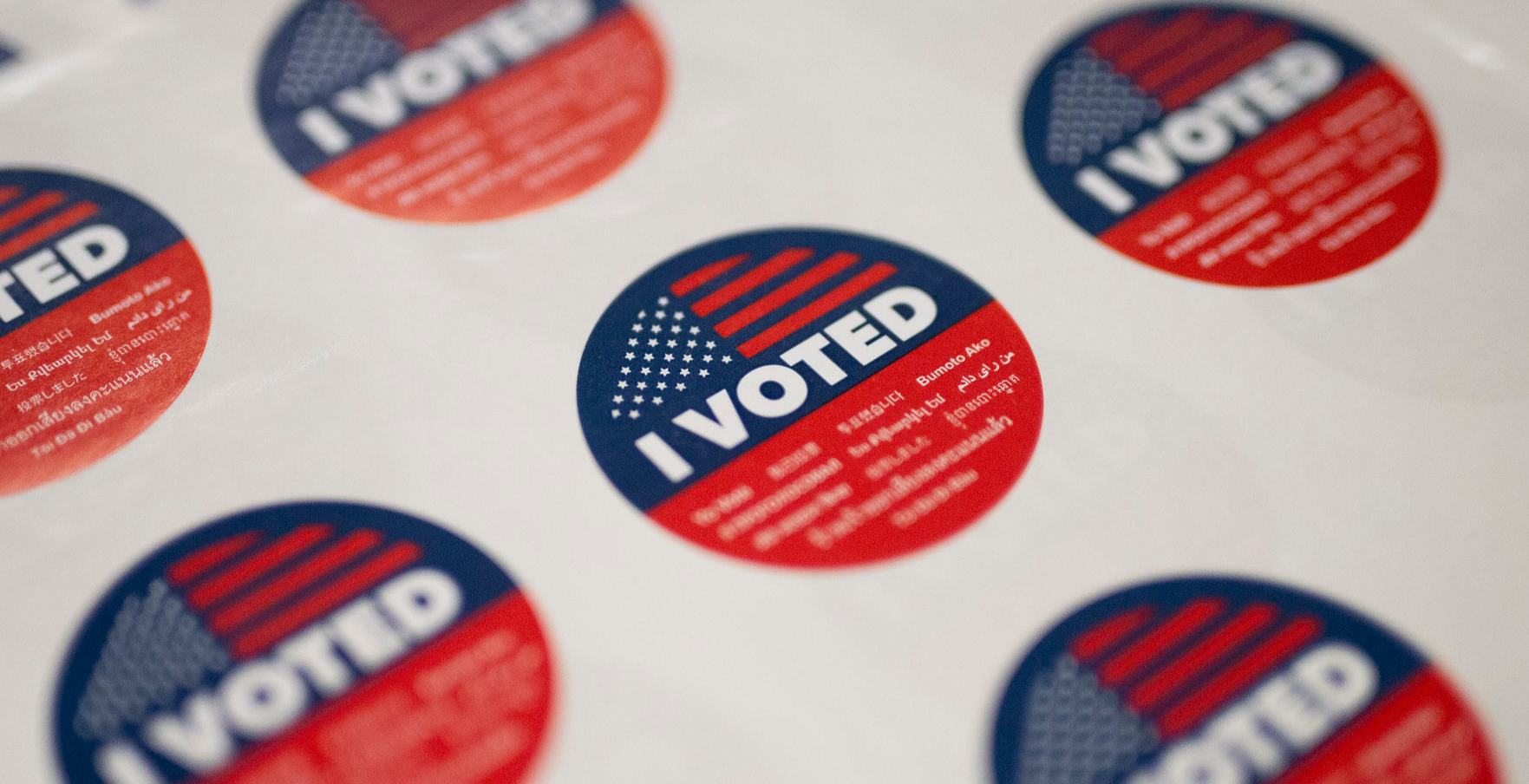
The Unique Women’s Coalition, Equality California and FLUX, a national division of the AIDS Healthcare Foundation, will host their second annual voter education town hall today at the Connie Norman Transgender Empowerment Center in Los Angeles from 7PM to 9PM tonight.
The organizations will present and discuss ballot propositions and measures that will appear on the November ballot and that affect the LGBTQ+ community in this part of the town hall series titled ‘The Issues.’
“The trans and nonbinary community is taking its seat at the table, and we are taking the time and space to be informed and prepare the voter base,” said Queen Victoria Ortega, international president of FLUX.
The town hall will feature conversations through a Q&A followed by a reception for program participants, organizational partners and LGBTQ+ city and county officials.
There will later be a third town hall before the election and The Connie Norman Transgender Empowerment Center will also become a voting location for anyone who feels like they need a safe space to vote, regardless of what voting district they are a part of.
“Our community is really asking for a place to talk about what all of this actually means because although we live in a blue sphere, housing and other forms of discrimination are still a very real threat,” said Scottie Jeanette Madden, director of advocacy at The Connie Norman Transgender Empowerment Center.
Southern California
Triple A: SoCal gas prices continue dropping quickly
The average price for self-serve regular gasoline in California is $4.87, which is 11 cents lower than a week ago
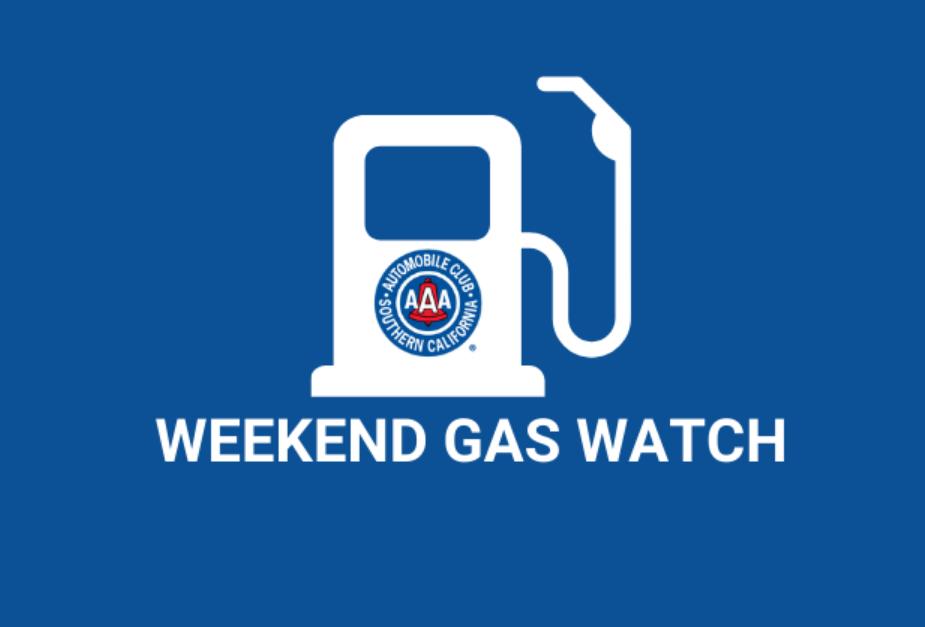
LOS ANGELES – Gas prices in Southern California have dropped by more than 50 cents a gallon in most areas after two straight months of price declines, according to the Auto Club’s Weekend Gas Watch. The average price for self-serve regular gasoline in California is $4.87, which is 11 cents lower than a week ago. The average national price is $3.46, which is two cents lower than a week ago.
The average price of self-serve regular gasoline in the Los Angeles-Long Beach area is $4.83 per gallon, which is 10 cents less than last week and 13 cents less than last year. In San Diego, the average price is $4.85, which is 10 cents lower than last week and eight cents lower than this time last year.
On the Central Coast, the average price is $4.97, which is five cents lower than last week and two cents higher than last year. In Riverside, the average per-gallon price is $4.75, which is 10 cents lower than last week and 10 cents lower than a year ago. In Bakersfield, the $4.96 average price is eight cents less than last week and nine cents higher than a year ago today.
“Oil Price Information Service reports the latest Energy Information Administration data shows that West Coast refinery utilization rates reached their highest production levels of 2024 at the beginning of this month,” said Auto Club Spokesperson Doug Shupe. “California continues to have the highest gas prices in the U.S., but this week for the first time since March, gas prices in most local areas are lower than at this time a year ago.”
The Weekend Gas Watch monitors the average price of gasoline. As of 9 a.m. on June 13, averages are:

Southern California
Triple A: Statewide gas price average drops below $5 a gallon
The average price for self-serve regular gasoline in California is $4.98, which is 11 cents lower than a week ago

LOS ANGELES – The California gas price average dropped below $5 a gallon for the first time since late March, according to the Auto Club’s Weekend Gas Watch. The average price for self-serve regular gasoline in California is $4.98, which is 11 cents lower than a week ago. The average national price is $3.48, which is eight cents lower than a week ago.
The average price of self-serve regular gasoline in the Los Angeles-Long Beach area is $4.93 per gallon, which is 12 cents less than last week and the same price as last year. In San Diego, the average price is $4.95, which is 12 cents lower than last week and six cents higher than this time last year.
On the Central Coast, the average price is $5.02, which is eight cents lower than last week and 12 cents higher than last year. In Riverside, the average per-gallon price is $4.95, which is 11 cents lower than last week and three cents higher than a year ago. In Bakersfield, the $5.04 average price is eight cents less than last week and 17 cents higher than a year ago today.
“According to Oil Price Information Service, Los Angeles wholesale gasoline prices are dropping as large supplies of imported gasoline continue to arrive in Southern California,” said Auto Club Spokesperson Doug Shupe. “A few Southern California gas stations are now charging less than $4.10 a gallon for regular unleaded.”
The Weekend Gas Watch monitors the average price of gasoline. As of 9 a.m. on June 6, averages are:

Southern California
‘Heat dome’ brings scorching conditions but coastal areas spared
The Los Angeles County Health Officer has issued an excessive heat warning as high temperatures have been forecast
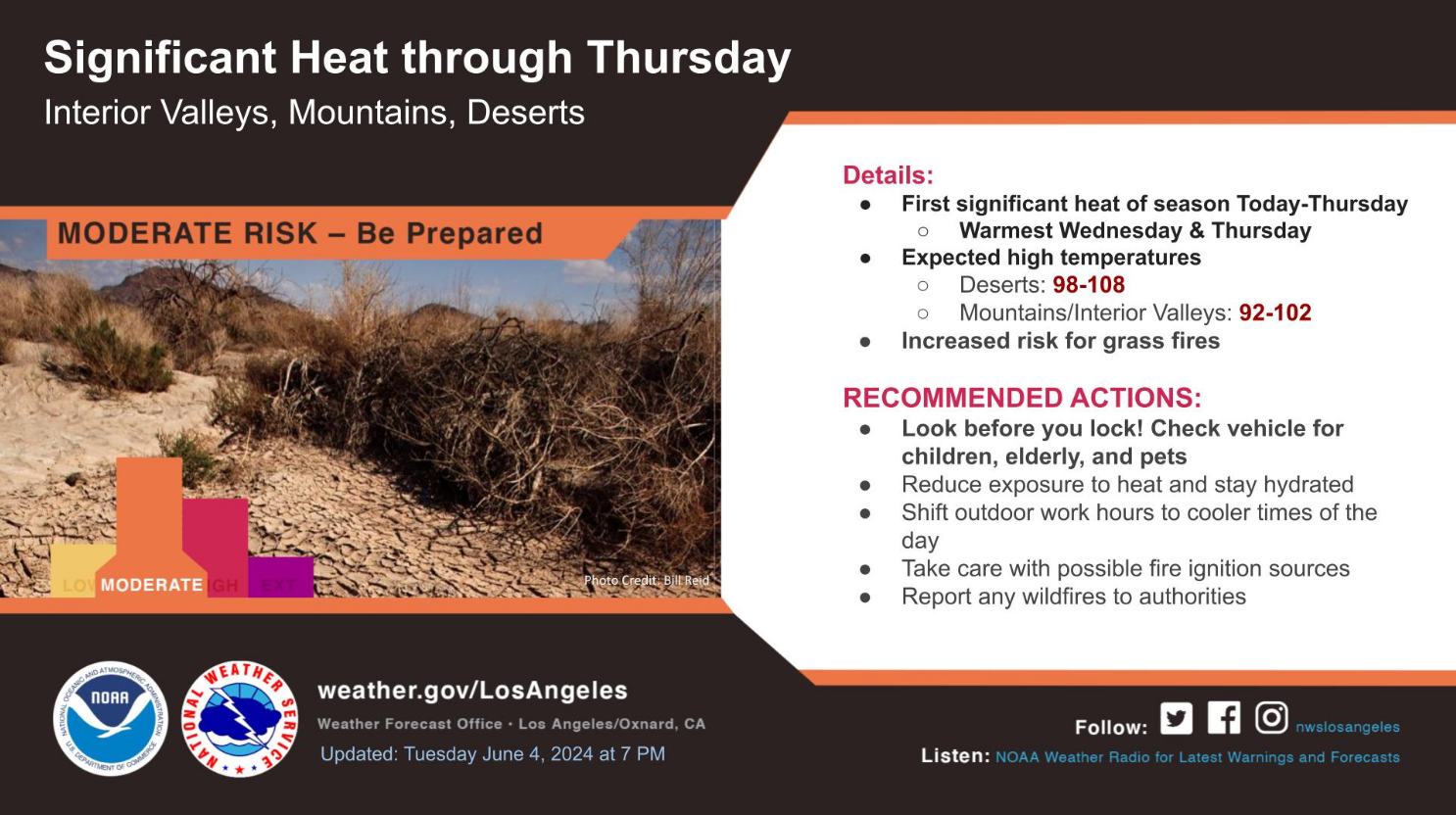
OXNARD, Calif. – The first significant heat of the season has arrived for the interior, and is expected to last into Thursday. Temperatures will be warmest Wednesday and Thursday, with highs in the deserts from 98 to 108, and 92 to 102 for the mountains and interior valleys.
Drier conditions along with breezy conditions will lead to an increased risk for grass fires. Reduce exposure to the heat, and stay hydrated. Look before locking vehicles for children, elderly and pets. Vehicles can become dangerously hot in a short period of time. Report any wildfires to authorities.
High Temperatures Forecast for Parts of Los Angeles County
The Los Angeles County Health Officer has issued an excessive heat warning as high temperatures have been forecast for the following areas:
- Antelope Valley: Wednesday June 05, 2024 through Thursday June 06, 2024
- Western Antelope Valley: Wednesday June 05, 2024 through Thursday June 06, 2024
- Eastern Antelope Valley: Wednesday June 05, 2024 through Thursday June 06, 2024
Public Health reminds everyone to take precautions to avoid heat-related illness, especially older adults, young children, outdoor workers, athletes, and people with a chronic medical condition who are especially sensitive to negative health impacts from extreme heat. Public Health offers the following recommendations during high temperature days:
- Drink plenty of water and keep hydrated throughout the day.
- If you must go out, plan your day to avoid going out during the hottest hours, and wear sunscreen. Wear lightweight, light-colored clothes, and wear a hat or use an umbrella.
- Cars get very hot inside, even if the windows are ‘cracked’ or open. Never leave children or pets in cars. Call 911 if you see a child or pet in a car alone.
- Beware of and know what to do for heat-related illness, such as heat exhaustion and heat stroke. Call 911 right away if you see these symptoms: high body temperature (103°F or higher), vomiting, dizziness, confusion, and hot, red, dry, or damp skin. Heat stroke is a medical emergency.
- Check on those at risk for heat-related illness, like those who are sick or have chronic conditions, older adults, pregnant women, children, those who live alone, pets, and outdoor workers and athletes.
- If you are wearing a mask, avoid strenuous workouts wearing face coverings or masks not intended for athletic purpose
- Visit your power company’s website or contact them by phone to determine if you are scheduled for a rolling power outage.
“On hot days, it’s important for everyone to both take care of themselves and check on others, especially those who have a higher chance of getting ill due to the heat. Some of them include children, the elderly, those with health conditions, pregnant people, those living alone, and pets,” said Muntu Davis, MD, MPH, Los Angeles County Health Officer. “Hot days can be dangerous for anyone, so it’s crucial to stay cool and hydrated. Never leave children, the elderly, or pets alone in hot homes, places, or vehicles. Make sure to check on elderly or unwell neighbors and relatives regularly.”
County and City partners have planned ways to safely operate cooling centers during times of high heat. Residents who do not have access to air conditioning are encouraged to take advantage of these free cooling centers. To find a location near you, visit https://ready.lacounty.gov/heat/ or call 211.
Los Angeles County residents and business owners, including people with disabilities and others with access and functional needs can call 2-1-1 for emergency preparedness information and other referral services. The toll-free 2-1-1 number is available 24 hours a day, seven days a week. 211 LA County services can also be accessed by visiting 211la.org.
Southern California
Triple A: Finally, some SoCal cities drop below $5 a gallon
The average price for self-serve regular gasoline in California is $5.09, which is six cents lower than a week ago

LOS ANGELES – Six straight weeks of price drops at Southern California gas stations have pushed average prices below $5 a gallon in a few cities, according to the Auto Club’s Weekend Gas Watch. The average price for self-serve regular gasoline in California is $5.09, which is six cents lower than a week ago. The average national price is $3.56, which is four cents lower than a week ago.
The average price of self-serve regular gasoline in the Los Angeles-Long Beach area is $5.05 per gallon, which is six cents less than last week and 12 cents higher than last year. In San Diego, the average price is $5.07, which is six cents lower than last week and 17 cents higher than this time last year.
On the Central Coast, the average price is $5.10, which is six cents lower than last week and 21 cents higher than last year. In Riverside, the average per-gallon price is $4.96, which is six cents lower than last week and 13 cents higher than a year ago. In Bakersfield, the $5.12 average price is five cents less than last week and 29 cents higher than a year ago today.
“Oil Price Information Service reports that wholesale Los Angeles gasoline prices are continuing to drop because of increased availability of imported gasoline and reportedly lower levels of demand compared to last year,” said Auto Club Spokesperson Doug Shupe. “Those factors should help pump price drops to continue for now.”
The Weekend Gas Watch monitors the average price of gasoline. As of 9 a.m. on May 30, averages are:

Southern California
Triple A: Memorial Day travelers get a break at the pump
The average price for self-serve regular gasoline in California is $5.15, which is nine cents lower than a week ago

LOS ANGELES – Gas prices continued downward for a fifth straight week, giving some Southern California Memorial Day travelers the chance to fill up for about $4.50 a gallon or even less in a few areas, according to the Auto Club’s Weekend Gas Watch. The average price for self-serve regular gasoline in California is $5.15, which is nine cents lower than a week ago. The average national price is $3.61, which is one cent higher than a week ago.
The average price of self-serve regular gasoline in the Los Angeles-Long Beach area is $5.11 per gallon, which is ten cents less than last week, 27 cents less than last month, and 25 cents higher than last year. In San Diego, the average price is $5.13, which is ten cents lower than last week, 23 cents lower than last month, and 29 cents higher than this time last year.
On the Central Coast, the average price is $5.16, which is five cents lower than last week, 17 cents lower than last month, and 30 cents higher than last year. In Riverside, the average per-gallon price is $5.02, which is ten cents lower than last week, 28 cents lower than last month and 25 cents higher than a year ago. In Bakersfield, the $5.17 average price is five cents less than last week, 15 cents less than last month, and 36 cents higher than a year ago today.
“With an all-time record number of Southern California travelers expected for this Memorial Day getaway weekend, the gas price drops are providing some welcome relief,” said Auto Club Spokesperson Doug Shupe. “Those travelers who are planning out-of-state trips should expect to pay even less when they fuel up for their return, since California continues to be the only U.S. state with a gas price average above $5 a gallon.”
The Weekend Gas Watch monitors the average price of gasoline. As of 9 a.m. on May 23, averages are:

Southern California
Triple A: Gas prices drop for four straight weeks
The average price for self-serve regular gasoline in California is $5.24, which is eight cents lower than a week ago

LOS ANGELES – Local gas prices have dropped for four straight weeks, but California continues to be the only state with an average price above $5 a gallon, according to the Auto Club’s Weekend Gas Watch. The average price for self-serve regular gasoline in California is $5.24, which is eight cents lower than a week ago. The average national price is $3.60, which is four cents lower than a week ago.
The average price of self-serve regular gasoline in the Los Angeles-Long Beach area is $5.21 per gallon, which is eight cents less than last week, 18 cents less than last month, and 37 cents higher than last year. In San Diego, the average price is $5.23, which is six cents lower than last week, 14 cents lower than last month, and 41 cents higher than this time last year.
On the Central Coast, the average price is $5.22, which is five cents lower than last week, 14 cents lower than last month, and 38 cents higher than last year. In Riverside, the average per-gallon price is $5.12, which is eight cents lower than last week, 19 cents lower than last month and 36 cents higher than a year ago. In Bakersfield, the $5.23 average price is three cents less than last week, eight cents less than last month, and 40 cents higher than a year ago today.
“California continues to have the highest average gas prices in the U.S., and despite a month of price declines, the state average price is still more than 40 cents higher than Hawaii, which is the second most expensive state for fuel,” said Auto Club Spokesperson Doug Shupe.
The Weekend Gas Watch monitors the average price of gasoline. As of 9 a.m. on May 16, averages are:

Southern California
Triple A: Gas prices head down for third straight week
The average price for self-serve regular gasoline in California is $5.32, which is six cents lower than a week ago

LOS ANGELES – Southern California gas prices have dropped for the third straight week, according to the Auto Club’s Weekend Gas Watch. The average price for self-serve regular gasoline in California is $5.32, which is six cents lower than a week ago. The average national price is $3.64, which is three cents lower than a week ago.
The average price of self-serve regular gasoline in the Los Angeles-Long Beach area is $5.28 per gallon, which is six cents less than last week, six cents less than last month, and 42 cents higher than last year. In San Diego, the average price is $5.29, which is five cents lower than last week, five cents lower than last month, and 44 cents higher than this time last year.
On the Central Coast, the average price is $5.27, which is six cents lower than last week, two cents lower than last month, and 41 cents higher than last year. In Riverside, the average per-gallon price is $5.20, which is seven cents lower than last week, five cents lower than last month and 43 cents higher than a year ago. In Bakersfield, the $5.26 average price is four cents less than last week, five cents more than last month, and 42 cents higher than a year ago today.
“According to Oil Price Information Service (OPIS), California and all West Coast refineries are continuing to operate at higher capacities and West Coast gasoline inventories are increasing in anticipation of higher summer demand,” said Auto Club Spokesperson Doug Shupe.
The Weekend Gas Watch monitors the average price of gasoline. As of 9 a.m. on May 9, averages are:

Southern California
Triple A: SoCal gas prices continue downward
The average price for self-serve regular gasoline in California is $5.38, which is three cents lower than a week ago

LOS ANGELES – Southern California gas prices are continuing to drop for a second straight week, according to the Auto Club’s Weekend Gas Watch. The average price for self-serve regular gasoline in California is $5.38, which is three cents lower than a week ago. The average national price is $3.67, which is one cent higher than a week ago.
The average price of self-serve regular gasoline in the Los Angeles-Long Beach area is $5.34 per gallon, which is three cents less than last week, 18 cents higher than last month, and 44 cents higher than last year. In San Diego, the average price is $5.34, which is two cents lower than last week, 19 cents higher than last month, and 45 cents higher than this time last year.
On the Central Coast, the average price is $5.33, which is the same as last week, 22 cents higher than last month, and 45 cents higher than last year. In Riverside, the average per-gallon price is $5.27, which is two cents lower than last week, 21 cents higher than last month and 45 cents higher than a year ago. In Bakersfield, the $5.30 average price is one cent less than last week, 29 cents more than last month, and 44 cents higher than a year ago today.
“After a few months of supply interruptions from refinery breakdowns and maintenance, Oil Price Information Service (OPIS) reports that California refineries have been operating at above 86% of their capacity for the past two weeks,” said Auto Club Spokesperson Doug Shupe. “Additionally, OPIS reported the US Energy Information Administration believes that the country has already experienced its highest gas price point for the first half of this year. Although California prices often go against national trends, that prediction is an encouraging sign for further price drops at the pump.”
The Weekend Gas Watch monitors the average price of gasoline. As of 9 a.m. on May 2, averages are:

Southern California
Triple A: Southern California gas prices begin to slowly decrease
The average price for self-serve regular gasoline in California is $5.41, which is four cents lower than a week ago

LOS ANGELES – Southern California gas prices slightly decrease in almost every metro city, according to the Auto Club’s Weekend Gas Watch. The average price for self-serve regular gasoline in California is $5.41, which is four cents lower than a week ago. The average national price is $3.66, which is also one cent higher than a week ago.
The average price of self-serve regular gasoline in the Los Angeles-Long Beach area is $5.37 per gallon, which is two cents less than last week, 33 cents higher than last month, and 44 cents higher than last year. In San Diego, the average price is $5.36, which is two cents lower than last week, 34 cents higher than last month, and 45 cents higher than this time last year.
On the Central Coast, the average price is $5.33, which is two cents lower than last week, 31 cents higher than last month, and 43 cents higher than last year. In Riverside, the average per-gallon price is $5.29, which is three cents lower than last week, 37 cents higher than last month, and 45 cents higher than a year ago. In Bakersfield, the $5.31 average price is the same as last week, 40 cents more than last month, and 43 cents higher than a year ago today.
“For the first time in almost two months prices in Southern California have slightly decreased,” said Auto Club Spokesperson Doug Shupe. “The reasons for gas prices moving lower include slowing domestic gasoline demand between Spring Break and summer travel, as well as the cost of crude oil retreating.”
The Weekend Gas Watch monitors the average price of gasoline. As of 9 a.m. on April 25, averages are:
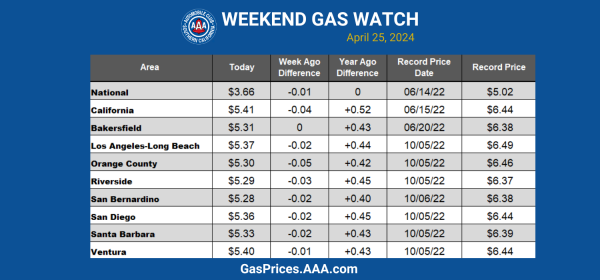
-
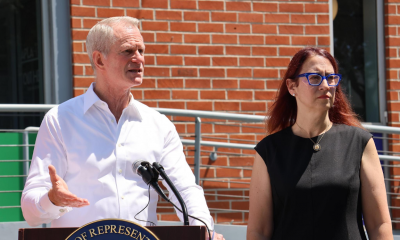
 Breaking News5 days ago
Breaking News5 days agoMajor victory for LGBTQ funding in LA County
-

 Features5 days ago
Features5 days agoKoaty & Sumner: Finding love in the adult industry
-

 Commentary3 days ago
Commentary3 days agoBreaking the mental health mold with Ketamine: insights from creator of Better U
-

 Miscellaneous4 days ago
Miscellaneous4 days agoCan you really find true love in LA? Insights from a queer matchmaker
-

 Arts & Entertainment4 days ago
Arts & Entertainment4 days agoIntuitive Shana gives us her hot take for July’s tarot reading
-

 Movies24 hours ago
Movies24 hours agoTwo new documentaries highlight trans history

